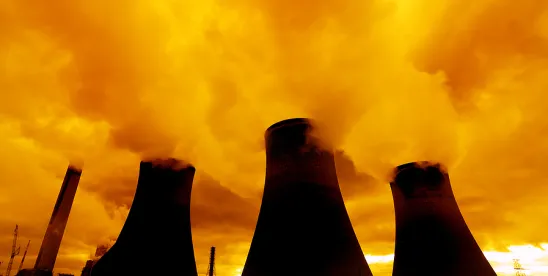The nuclear energy industry continues to gain momentum and has a strong outlook for 2025 and beyond. This positive forecast is buoyed by support from both major political parties, increased demand, technical advancements, and some out-of-the-box thinking for deploying existing assets. There have also been a few notable judicial and legislative developments that are contributing to what some hope will be the realization of a long-promised nuclear renaissance.
Outlook for 2025 and Beyond
The new year is already off to a good start for nuclear power generation.
Expansion of the Price-Anderson Act
First, the US Court of Appeals for the Federal Circuit recently advanced a broad interpretation of the Price-Anderson Act that will expand the definition of private parties covered for certain nuclear accidents. This positive development broadens who can take advantage of government indemnification under the Price-Anderson Act, encouraging new parties to participate in the nuclear market. We wrote about this development and its impact on limiting private liability for nuclear accidents here.
Nuclear Market Growth
Second, a dynamic nuclear market appears to be taking root. As Nuclear Business Platform reports: (1) small modular reactors (SMRs) should lead the way in 2025, with several designs under development and NuScale Power Corporation achieving US Nuclear Regulatory Commission (NRC) certification; (2) increased demand from data centers and artificial intelligence should continue to drive new generation; (3) a positive financing environment for nuclear projects also appears to be in place; (4) new technology developments in both reactors and fuels from a variety of private market players should support further growth; and (5) new market participants in India, Turkey, and Africa will also support continued advancements and efficiencies.
Nuclear-Powered Hydrogen
Third, the US nuclear industry continues to evaluate opportunities for using nuclear fuel as an electricity source to produce hydrogen following the US Department of the Treasury’s final changes to the 45V clean hydrogen production tax credit, which exempt (with some restrictions) existing and future nuclear power plants from the additionality requirements imposed on other renewable energy sources. US nuclear leaders, along with EDF Energy’s initiatives in France and Japan’s High Temperature Engineering Test Reactor, could carve out a new generation space.
Global Agreements to Support Nuclear Power
Fourth, a collection of large tech companies, financial institutions, and members of the nuclear industry announced a pledge at the CERAWeek conference to “triple global nuclear capacity by 2050.” The coalition, including Amazon, Meta, Google, key nuclear power associations, and 31 countries, committed to supporting the rapid expansion of global nuclear power through financial investment, aggressive political advocacy, and global cooperation.
Palisades Nuclear Plant Set to Restart
Fifth, on Monday, 17 March, the US Department of Energy (DOE) approved a nearly US$57 million loan disbursement to Holtec for the Palisades Nuclear Plant in Covert, Michigan. The Palisades plant, retired in 2022, could be the first commercial reactor in the country brought back into service after being previously shut down. US Energy Secretary Chris Wright called the disbursement “yet another step toward advancing President Trump’s commitment to increase domestic energy production, bolster our security and lower costs for the American people.” The Palisades plant will have to receive approval from the NRC to resume operation.
World Bank Set to Invest in Nuclear Projects
Sixth, on Thursday, 20 March, the head of the World Bank announced that he had petitioned the bank’s board of directors to reverse its policy against investing in nuclear energy projects. Ajay Banga, the World Bank president, called small nuclear reactors “transformative and safe,” and he stated that nuclear power could be a viable path to green power for developing countries.
Support for Nuclear from the Trump Administration
Finally, the Trump administration has released several statements and executive orders promoting new nuclear generation. On his first day in office, President Trump issued the “Unleashing American Energy” executive order, which directed agencies to identify, revise, or rescind any regulations that “unduly burdened” domestic energy production. Among the domestic energy sources identified as key domestic resources, nuclear energy was included. President Trump, along with Secretary of Energy Chris Wright and Secretary of the Interior Doug Burgum, have expressed public support for increasing nuclear capacity as a reliable source of baseload power for the US electrical grid.
2024 in Review
The promise of 2025, and beyond, comes on the heels of an extremely successful 2024 in the commercial nuclear industry. DOE recently summarized the major nuclear achievements from 2024.
New Reactors Come Online in Georgia
Vogtle 4 entered commercial service on 29 April 2024. Plant Vogtle is now the largest clean power generator in the country and is home to two Westinghouse AP1000 reactors. These are the first new builds in the United States in more than 30 years.
Significant Restart and Recommissioning Activity Is on the Horizon
DOE closed a US$1.52 billion loan to repower and upgrade the Palisades nuclear power plant in Michigan. This would be the first reactor ever recommissioned in the United States, if approved by the NRC. Holtec’s decision to recommission Palisades is significant because the company originally purchased the plant with plans to decommission the plant at a profit. Holtec’s decision to stick with the plant provides a clear signal as to the improved economics and demand for nuclear power generation. The DOE loan was made possible by the Inflation Reduction Act.
In addition to Palisades, Constellation Energy recently announced its plans to restart Three Mile Island Unit 1, thanks to a 20-year power purchase agreement with Microsoft to power its data centers. The plant will be renamed the Crane Clean Energy Center and is expected to be online in 2028, pending regulatory approval.
The United States Announces Nuclear Generation Goals
The Biden administration released nuclear deployment targets in 2024 to expand domestic capacity by 200 gigawatts (GW). The plan outlines more than 30 actions the US government can take to add 35 GW of new capacity by 2035 and achieve a sustained pace of 15 GW per year by 2040. Most of that capacity could come from existing power plant sites. Research also shows that US nuclear power plants could host up to 95 GW of new capacity. An additional 174 GW could also be built near US coal plants, depending on the reactor type. The Trump administration has not specifically endorsed the Biden plan, but, as discussed above, the Trump administration has expressed support for a “nuclear renaissance.”
Strides Being Made in Development of a Domestic Nuclear Fuel Supply
Multiple companies are participating in low-enriched uranium and high-assay, low-enriched uranium capacity building programs sponsored by DOE. The US$3.4 billion effort will allow the awardees to bid on future task orders to produce, store, and deconvert material that can be fabricated into fuel for current and future reactors. The United States also took crucial steps toward strengthening our domestic energy security by issuing a ban on imported uranium products from Russia.
New Technologies Are Under Development
DOE-supported projects started in 2024 will bring the United States one step closer to the deployment of new advanced small modular and microreactor systems. TerraPower started nonnuclear construction on a sodium test facility in support of its Natrium reactor in Kemmerer, Wyoming. The Department of Defense broke ground on its Project Pele microreactor at Idaho National Laboratory. X-energy, which is already developing its high-temperature, gas-cooled reactor technology with Dow in Texas, announced a commitment from Amazon for a 320-megawatt project with Energy Northwest in Washington State. Kairos Power also started construction on its Hermes reactor in Oak Ridge, Tennessee. The project is one of several projects being supported through DOE’s Advanced Reactor Demonstration Program.
DOE Launched a US$900 Million Program to Demonstrate up to Two Advanced Light-Water Small Modular Reactor Systems in the United States
The new program encourages a consortium-based approach to lower the risk of deploying new reactor technologies. It will also facilitate multi-reactor order books and provide additional support to build out the advanced light-water reactor supply chain.
The ADVANCE Act to Address the Speed of Licensing New Reactors
Four years after President Trump signed the 2019 Nuclear Energy Innovation and Modernization Act, President Biden signed another key bipartisan bill known as the ADVANCE Act to help speed up the deployment and licensing of new reactors and fuels. The new bill helps develop a modernized approach to licensing new reactor technologies. The bill also makes strides to develop guidance for smaller reactor technologies and advanced fuel cycles.
In response to Congress’s legislation directing NRC to develop new frameworks for licensing nuclear technology, NRC is currently in the process of crafting two new regulatory processes—one for advanced reactor technology like SMRs and microreactors, and another for fusion energy machines under the byproduct materials rule. The new licensing regulations are designed to streamline applications to NRC and allow for design-specific safety reviews of first-of-a-kind reactor technology. The final rule for advanced reactor technology is expected to be issued in summer 2026, and the proposed rule for fusion machines is expected to be published in May 2025.
Further, in February 2025, NRC published its proposed fee schedule fiscal year 2025. The new fee schedule would reduce the hourly fee for advanced reactor pre-applicants and applicants by 50%, from US$146/hour to US$323 per hour. The rule is set to take effect on 1 October 2025.
New Areas of International Cooperation Were Put Forward
DOE launched the world’s first two regional Clean Energy Training Centers in Poland and Ghana this year to jump-start the countries’ domestic civil nuclear energy programs. The centers will serve the regions as training hubs for countries considering new or expanded nuclear reactor deployments and will build on previous international agreements to grow global nuclear energy capacity.
Additional Proposed Solutions to Deal with Spent Nuclear Fuel
DOE is moving forward on a project to design, build, and operate a federal consolidated interim storage facility for spent nuclear fuel that would be sited through DOE’s consent-based siting process. The facility would be licensed by NRC and initially built to store around 15,000 metric tons of spent nuclear fuel, with options to expand. It would also include the development of new modern railcars to transport the spent fuel.
The firm is actively monitoring the exciting growth of nuclear power in the United States and across the world. As nuclear policy continues to evolve, and opportunities in the nuclear industry continue to grow, the energy, policy, and regulatory professionals at the firm stand ready to help guide you through the exciting developments happening now in nuclear energy.







 />i
/>i

